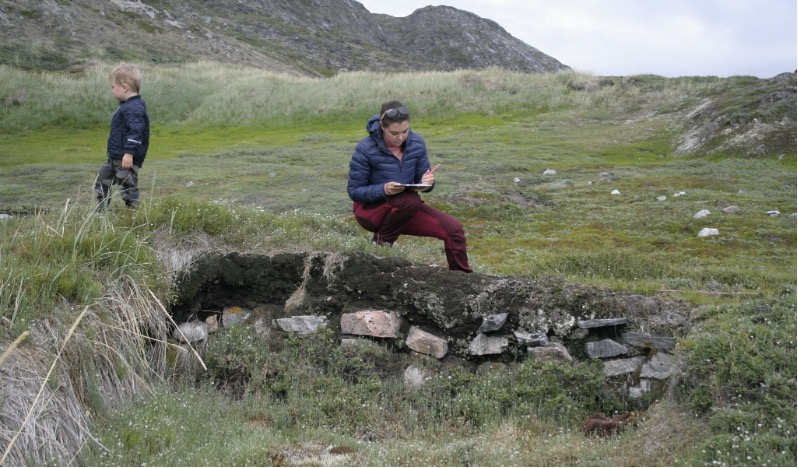The Inuulluni Project: Inuit Perspectives of the Winter House and Greenlandic Landscape
9 September 2021
By Asta Mønsted
According to Nordisk Samarbejde (Nordic Co-operation), the time a private home seeker must wait for a public rental home in Nuuk today is between 10 and 12 years. This is in a country that has centuries long tradition for Inuit families building their own homes, or rebuilding older ruins to fit their family size. This separation of, on one hand, the architect and builder of the house, and, on the other hand, the actual user of the house has happened gradually since the Danish colonization of the country in 1721. Since then, the Danish government overtook the building process meant to house Inuit. An exception here are the self-builders, who buy a house set and build it themselves with the possibility of making alterations along the process (Susane Havelka, ongoing study).
The Inuulluni-project aims to take the Inuit perspective on the winter house, and it wishes to argue that ideas and concepts of the old Inuit ruins can be relevant and even add a cultural sustainability to the future architecture of Greenland. Where prior studies of Inuit architecture and landscape often had the character of aiming to understand Inuit based on economic and constructive rationalization, it has within recent decades been discussed how architecture can equally be rooted in cosmological references and conceptions. So, by involving and examining indigenous oral tradition in relation to architecture, researchers gain a deeper understanding of how indigenous people’s world perception is reflected and influences their architectural designs of the archeological remains that we see today. And the old ruins may carry symbolic and specialized secrets that we would need to unlock today.
Combined with archaeological fieldwork, the project has conducted a systematic search in the Myth and Legend-database (Arctic Institute, Denmark), containing 2.280 narratives all collected in Greenland between 1735 and up until 1981. The rationale was to extract ideas, concepts, and ritual activities Inuit had connected to various architectural elements prior to Danish colonization. The study thereby made room for ancient voices to be heard in their own right, and they testified of a world where humans were on equal terms with other living creatures (animals, spirits, and supernatural beings) trying to make a living. The Inuit lived in symbiosis with nature. Those might have been different times, but we may re-learn from the past how to stay rooted as Inuit in Greenland.

The Greenlandic society may re-learn that the Inuit winter house used to have what we can perceive of as a ‘soul’: it was built of organic materials like whale bones, turf, and skins that made the house breathable, and without maintenance, it would slide and collapse just like the aging human body. Also, the Inuit winter house used to have what we may perceive of as a ‘face’ with the entrance tunnel as a throat, the windows as eyes, and a ventilating hole called illup sorlua (the house’s nostrils). The house was connected to mortal rituals where the deceased would be carried out of the house through a newly made hole in the back wall or in the roof since these architectural elements represented the human behind, where the human soul (tarneq) would enter and exit a body (timeq). The Inuit oral tradition gives several examples of how to deal with the Arctic environment.
Today, we see housing constructions made of concrete and squared corners that could have been built anywhere in this world. And if anything, these kinds of buildings alienate us from our environment. Not only because these buildings are made of concrete, but more importantly, because the Inuit are no longer part of the design nor the construction of the home they are supposed to live in. The Inuit of Greenland do no longer think and dwell in a forever generating process, as Heidegger said we ought to (1993).
The Greenlandic oral narratives testify of ingenuity and resilience among the Inuit, who did not live despite the harsh conditions, but they formed alliances with them. The next Arctic generations may use this as a foundation to rethink, design, and build the future homes and urban environments in which they may mirror themselves and their own values. Every second year, the conference of ‘Future Greenland’ is held in Nuuk. In 2022 it will be the seventh conference, and it is Greenland’s biggest business conference with more than 400 people participating in workshops and debates. They constitute a broad spectrum of people interested in social issues, they are members of parliament and people of the local municipalities, public servants, students, just as there are participants from Canada, USA, and several nordic countries. However, the author misses someone who represents the country’s national history. Because indigenous knowledge is not primitive and in contrast to technology. Indigenous knowledge is technology refined over millennia.
Asta Mønsted is currently taking her Ph.D. degree at the University of Copenhagen. She was born and raised in Uummannaq, Greenland, and is specializing in Greenlandic architecture and landscape, but has also conducted fieldwork in Germany and Japan.
Cited literature:
-
Heidegger, M. 1993. Building, Dwelling, Thinking. In D. F. Krell (ed.) Basic Writings from ‘Being and Time’ (1927) to The Task of Thinking (1964), London, Routledge
-
Madsen, J. C. 2000. Grønlandske boliger – selvbyggeri og typehuse, Forlaget Atuagkat
-
Nordisk Samarbejde: https://www.norden.org/da/info-norden/bolig-i-groenland
-
Susane Havelka: https://www.mun.ca/geog/people/faculty/shavelka.php
- From the Floe Edge: Visualising Sea Ice in Kinngait, Nunavut
- Bridging Knowledge and Action: A Polish-Norwegian Perspective on Arctic Science-Policy Collaboration
- Unpacking the Motivation Behind Wintering at Polar Stations
- Working the Ocean’s White Gold: A Nutshell History of a Living Bering Strait Tradition
- Political Participation in the Arctic: Who is heard, when, and how?

